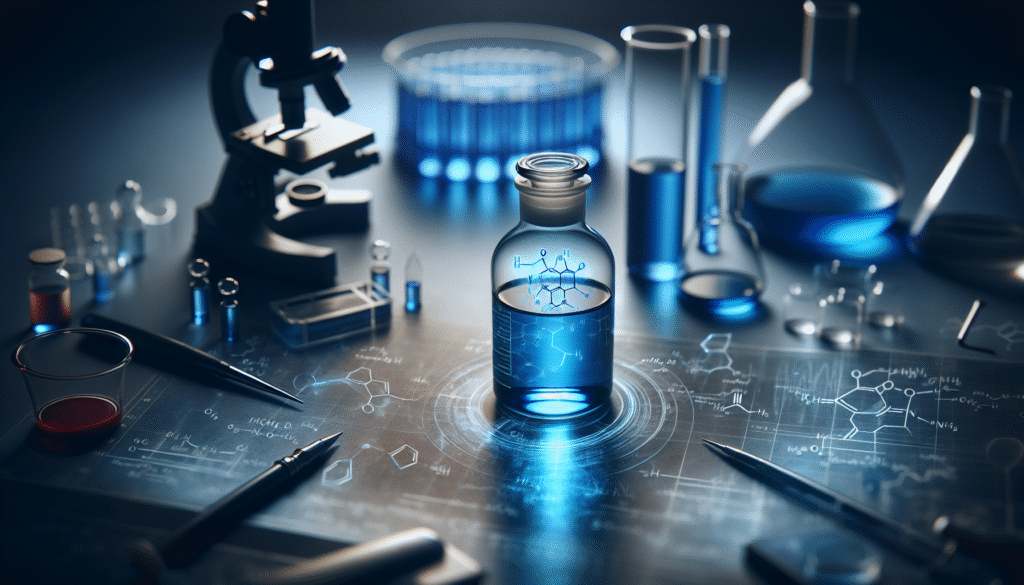
Have you ever considered the complex roles that chemical compounds can play in both medicine and biology? One such compound is Methylene Blue, a substance known for its diverse applications, ranging from treating medical conditions to being a stain in laboratory settings. Understanding the mechanisms and effects of Methylene Blue offers valuable insight into its potential benefits and risks. This article will guide you through the intricacies of Methylene Blue, from its historical context to its modern applications.
Historical Context
Methylene Blue has a storied past, initially synthesized in the 19th century. Initially developed as a dye, it was one of the first synthetic colorants used in textiles. However, its medicinal properties soon gained attention. This transition from a mere dye to a therapeutic agent highlights the dual nature of many chemical compounds.
The Evolution of Methylene Blue Use
Methylene Blue was first introduced in the clinical setting as a treatment for malaria in the early 20th century. The compound’s ability to affect redox reactions in biological systems became a focal point for researchers seeking to understand its therapeutic effects. Over time, it has been explored for a variety of other applications, including:
- Methemoglobinemia: A condition where hemoglobin is unable to effectively release oxygen.
- Cognitive enhancement: Investigated for potential memory and cognitive benefits.
- Antimicrobial properties: Used in some contexts as an antiseptic.
Understanding the historical context provides a clearer picture of why Methylene Blue is a focal point of research and debate in the medical community.
Chemical Structure
To comprehend the effects of Methylene Blue, one must first understand its chemical structure. Methylene Blue is a thiazine dye with the chemical formula C16H18ClN3S. Its structure comprises a central carbon atom surrounded by nitrogen atoms, which contributes to its unique properties.
Key Chemical Features
- Electron Configuration: Methylene Blue has a complex electron configuration, allowing it to engage in redox reactions.
- Solubility: It is water-soluble, giving it the ability to easily interact with biological systems.
- Chroma: The deep blue color of Methylene Blue is indicative of its electron absorption capabilities.
These features contribute significantly to its mechanism of action in biological settings.

Mechanisms of Action
Understanding how Methylene Blue operates within biological systems is crucial. Its mechanisms are complex and multifaceted, impacting various physiological processes.
Antioxidant Properties
Methylene Blue has antioxidant capabilities, allowing it to neutralize free radicals in the body. This function is essential for maintaining cellular health as oxidative stress is linked to various diseases.
- Mechanism: It acts by reducing reactive oxygen species (ROS), thereby protecting cells from damage.
- Relevance: This property makes it a candidate for research into conditions exacerbated by oxidative stress, such as neurodegenerative diseases.
Role in Methemoglobinemia
One of the most well-documented uses of Methylene Blue is in treating methemoglobinemia. The drug acts primarily by facilitating the conversion of methemoglobin back to hemoglobin.
- Mechanism: Methylene Blue donates electrons to the methemoglobin molecule, allowing it to revert to its functional form.
- Clinical Use: Administered intravenously, it has proven effective in acute cases and is typically well tolerated.
This specific mechanism showcases Methylene Blue’s potential in emergency medicine and highlights its therapeutic role.
Cognitive Enhancement
Recent studies have suggested that Methylene Blue may offer cognitive enhancement benefits, particularly in scenarios of reduced cognitive function or memory decline.
- Mechanism: It is believed to enhance mitochondrial function, leading to improved energy production and neuronal health.
- Research Findings: Some studies indicate increased memory retention in both animal models and human trials, although further research is needed to solidify these claims.
This aspect of Methylene Blue’s action opens up a pathway for discussions around cognitive health, aging, and potential therapeutic avenues.
Medical Applications
Methylene Blue’s wide-ranging effects have led to its application in various medical fields. Understanding these applications can help you evaluate its potential benefits and drawbacks.
Treatment of Methemoglobinemia
As previously discussed, the primary medical use of Methylene Blue is the treatment of methemoglobinemia. This condition can arise from genetic factors or exposure to certain chemicals and drugs.
| Condition | Treatment Method | Dosage |
|---|---|---|
| Methemoglobinemia | Methylene Blue (IV) | 1-2 mg/kg |
The quick response time and efficacy of Methylene Blue in such cases underline its importance in emergency medicine.
Antidepressant Properties
There is emerging evidence that Methylene Blue may play a role in treating some forms of depression. This application is particularly pertinent given the rising rates of depression globally.
- Mechanism: It may optimize serotonin pathways and influence monoamine levels in the brain.
- Clinical Applications: Some studies suggest its potential use in adjunctive therapy with standard antidepressants.
Understanding the implications of these findings is vital, particularly as mental health continues to be a topic of growing concern.
Antimicrobial Activity
Methylene Blue possesses notable antimicrobial properties, allowing it to act effectively against various bacterial and fungal pathogens.
- Mechanism: Its ability to generate reactive oxygen species under light exposure enhances its antibacterial effects, making it suitable for certain topical applications.
- Research Implications: This aspect of Methylene Blue can be critical in developing new treatments for antibiotic-resistant infections.
The potential use of Methylene Blue in combating resistance highlights the need for continued research and exploration in microbial health.

Safety and Side Effects
Despite its potential benefits, it is important to consider the safety and side effects of Methylene Blue. Understanding these aspects is crucial for informed decision-making regarding its use.
Common Side Effects
While Methylene Blue is generally considered safe when used properly, several side effects may arise, particularly with improper usage.
- Skin Discoloration: Often the most noticeable, it can cause blue staining of the skin or urine.
- Gastrointestinal Issues: Some individuals may experience nausea, vomiting, or abdominal pain.
- Headache: A common side effect reported post-administration.
Awareness of these possible side effects can better prepare you should you ever encounter the substance in a medical setting.
Contraindications
Certain populations may need to avoid Methylene Blue entirely. Understanding these contraindications is vital for minimizing risks.
- G6PD Deficiency: Individuals with this enzyme deficiency are at risk for hemolytic anemia when treated with Methylene Blue.
- Pregnancy and Lactation: Limited research suggests potential risks, warranting caution for pregnant and breastfeeding women.
This understanding allows for more informed discussions when considering Methylene Blue’s use in various demographics.
Current Research Trends
The landscape of Methylene Blue research is constantly evolving. Staying abreast of current trends can be beneficial for recognizing the substance’s emerging applications.
Neuroprotective Effects
Recent studies are increasingly examining Methylene Blue’s neuroprotective effects, particularly in diseases like Alzheimer’s and Parkinson’s.
- Mechanism: The compound appears to facilitate mitochondrial function, preventing neuronal death.
- Research Findings: Early results demonstrate promise, but extensive longitudinal studies are necessary for conclusive evidence.
These research endeavors open up possibilities for new therapeutic strategies in treating neurodegenerative conditions.
Role in Cancer Treatment
Increasing interest has surfaced around Methylene Blue’s potential role in oncology, particularly in photodynamic therapy.
- Mechanism: Its ability to produce reactive oxygen species under specific wavelengths of light can aid in targeting cancer cells.
- Current Studies: Ongoing trials are assessing its effectiveness in various cancers, though results thus far remain preliminary.
Future findings may revolutionize how we approach cancer therapies, particularly as resistance to conventional treatments continues to grow.
Conclusion
Understanding Methylene Blue — its mechanisms, effects, risks, and potential — paints a complex picture of this multifaceted substance. Its journey from a simple dye to a medically significant compound enriches the narrative of many chemical agents in our healthcare system. As research continues to evolve, you remain positioned at the forefront of discovering how Methylene Blue can play a vital role in health and medicine. It embodies the promise and peril of scientific innovation, encouraging careful exploration of its myriad applications.